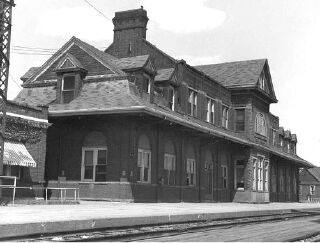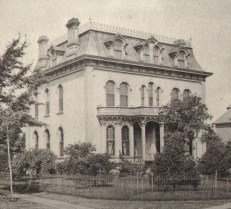I’ve been preparing a double-sided informational handout regarding historic preservation, and ran across an older (undated) Michigan SHPO brochure that is very much worth remembering and reading. It doesn’t look that old to me, but it includes information about the state tax incentive program, which hasn’t been active for years. The point being, however, that I think the brochure was well-conceived and well-written, so I’m reproducing most of it here (I added the two color photos). I hope you find it informative and inspirational! A copy of it online, in its original form, can be found here.
Building a Future with Historic Places
Historic places define communities and define Michigan.
What Historic Preservation Does for You
Transforms Communities Throughout Michigan, buildings once abandoned or underappreciated and underutilized can be transformed into vibrant structures that attract people to downtowns. Once rehabilitated, these structures can make enormous contributions to Michigan’s economic revitalization. A prime example is the Grand Rapids Water Filtration Plant, a utilitarian building converted to office and residential space. The 45,000 square-foot structure sat vacant for 15 years. The DeVries Companies, using historic preservation tax credits, rehabilitated the building.

Clear Water Place, a recycled water filtration plant (1430 Monroe Ave NW, Grand Rapids, http://devriescompanies.com/property/1430-monroe-ave-nw-grand-rapids-mi/).
Inspires Your Neighbors One historic rehabilitation in a neighborhood can be a catalyst. State Historic Preservation Tax Credits can breathe new life into neighborhoods where neglected rental properties as well as owner-occupied homes have deteriorated. A large gray house in Kalamazoo’s South Street Historic District known as ‘the gray battleship,’ with a reputation as a crack house and an eyesore, set a new tone in the neighborhood when new owners rehabilitated the house using state historic preservation tax credits. In the process they inspired other owners in the neighborhood to do the same.
Invites You Downtown Michigan’s Main Streets provide small business entrepreneurs with the space to do business. The State Historic Preservation Office along with the Michigan Main Street Center, a sister agency in the Michigan State Housing Development Authority (MSHDA), works with communities to target the revitalization and preservation of their traditional commercial districts. The Michigan Main Street program encourages the rehabilitation of downtown buildings, investment in downtown businesses, and a desire to live, work and play downtown.
Connects You to the Four Tops, Father Marquette and Henry Ford These Michigan history icons are just a few of the people associated with some 1,800 historic above-ground and archaeological sites in Michigan listed in the National Register of Historic Places. The Four Tops performed in the African American resort community of Idlewild, a historic district of more than 1000 properties. Father Jacques Marquette had a mission at what is now St. Ignace. Idlewild and the mission site are both listed in the National Register of Historic Places, as are multiple sites associated with Henry Ford. Historic preservation doesn’t just connect us to icons, however. The National Register of Historic Places recognizes places significant in our past that are associated with people who made Michigan, some of them just like you.
Informs You About the Past Underground and Underwater Archaeology is a source of information about the past, similar to archival documents, but different as well. Artifacts and other evidence provide information about 12,000 years of Native American history before written records were created. Archaeology also offers insights not available in written documents for the past 400 years of Michigan history since the arrival of Europeans. There are more than 20,000 archaeological sites recorded in Michigan, including Native American camp and village sites, Jesuit mission sites, fur trading posts, logging camps, farm complexes, and shipwrecks on Michigan’s Great Lakes bottomlands. The identification and protection of archaeological sites is crucial to preserving a source of information vital to our understanding of Michigan’s past.
Values Your Modernism Michigan’s impressive twentieth century design history creates an image for our state, based on the vibrant, creative auto and furniture design that spilled over into architecture and urban design. That history is the foundation for Michigan’s design industry today. The Michigan Modern project focuses on modern architecture from 1940 to 1970. Michigan Modern, funded through a federal Preserve America grant, is a research-intensive step to claiming Michigan’s rightful position as an international leader in modern design.

One of Port Huron’s own Moderns by Dow, the Henry McMorran Memorial Sport Arena and Auditorium. http://www.michiganmodern.org/buildings/henry-mcmorran-memorial-sports-arena-and-auditorium
The historical and cultural foundations of the Nation should be preserved as a living part of our community life and development in order to give a sense of orientation to the American people.
National Historic Preservation Act of 1966
Helps Your Environment According to the Environmental Protection Agency, roughly one-third of landfill waste comprises construction and demolition debris. Historic rehabilitation and the adaptation of an existing building for a new use minimizes the amount of debris in landfills and takes advantage of the embodied energy of the materials, which typically consumes less energy than new materials. The State Historic Preservation Office promotes using existing materials as much as possible and replacing them with like materials when necessary. The SHPO awarded a federal Certified Local Government grant to the city of Kalamazoo, which partnered with the Michigan Historic Preservation Network and trained unemployed and underemployed contractors to rehabilitate wood windows as an alternative to replacement. In addition, SHPO staff educates communities receiving federal weatherization funds about the possibilities for rehabilitation and weatherization.
Keeps Your Lights On Lighthouses are synonymous with Michigan, which has more than any other state. Driving throughout the Great Lakes State, you cannot help but notice lighthouses along the shorelines and the Save Our Lights license plates on the cars of Michigan drivers. Revenue from the sale of the lighthouse license plates funds the Michigan Lighthouse Assistance Program, which supports the rehabilitation of these important structures. Since 2000 more than $1 million dollars in grants have been awarded.
Builds Your Future Michigan communities are constantly changing and evolving. Through planning and protection, the SHPO works with individuals and communities to ensure that Michigan’s important historic resources, which define us, are part of future growth. Historic preservation can be an important part of community and economic planning and development efforts. The SHPO builds partnerships and encourages reinvestment in historic neighborhoods and downtowns so the best of Michigan’s heritage is preserved while fostering long-term economic growth and stability. Through its role in the implementation of federal and state preservation law, the SHPO is a key factor in the timely and efficient release of public funds while protecting cultural resources.























